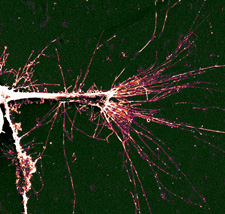Changing the texture and surface characteristics of a semiconductor material at the nanoscale can influence the way that neural cells grow on the material.
 This image shows a PC12 cell growing onto a randomly textures surface. Note how the cell is spreading out in all directions. (Click to enlarge.)
This image shows a PC12 cell growing onto a randomly textures surface. Note how the cell is spreading out in all directions. (Click to enlarge.)
The finding stems from a study performed by researchers at North Carolina State University, the University of North Carolina at Chapel Hill and Purdue University, and may have utility for developing future neural implants.
“We wanted to know how a material’s texture and structure can influence cell adhesion and differentiation,” says Lauren Bain, lead author of a paper describing the work and a Ph.D. student in the joint biomedical engineering program at NC State and UNC-Chapel Hill. “Basically, we wanted to know if changing the physical characteristics on the surface of a semiconductor could make it easier for an implant to be integrated into neural tissue – or soft tissue generally.”
The researchers worked with gallium nitride (GaN), because it is one of the most promising semiconductor materials for use in biomedical applications. They also worked with PC12 cells, which are model cells used to mimic the behavior of neurons in lab experiments.
In the study, the researchers grew PC12 cells on GaN squares with four different surface characteristics: some squares were smooth; some had parallel grooves (resembling an irregular corduroy pattern); some were randomly textured (resembling a nanoscale mountain range); and some were covered with nanowires (resembling a nanoscale bed of nails).
Very few PC12 cells adhered to the smooth surface. And those that did adhere grew normally, forming long, narrow extensions. More PC12 cells adhered to the squares with parallel grooves, and these cells also grew normally.
About the same number of PC12 cells adhered to the randomly textured squares as adhered to the parallel grooves. However, these cells did not grow normally. Instead of forming narrow extensions, the cells flattened and spread across the GaN surface in all directions.
More PC12 cells adhered to the nanowire squares than to any of the other surfaces, but only 50 percent of the cells grew normally. The other 50 percent spread in all directions, like the cells on the randomly textured surfaces.
“This tells us that the actual shape of the surface characteristics influences the behavior of the cells,” Bain says. “It’s a non-chemical way of influencing the interaction between the material and the body. That’s something we can explore as we continue working to develop new biomedical technologies.”
The paper, “Surface Topography and Chemistry Shape Cellular Behavior on Wide Band-Gap Semiconductors,” is published in Acta Biomaterialia. Senior author of the paper is Dr. Albena Ivanisevic, an associate professor of materials science and engineering at NC State and associate professor of the joint biomedical engineering program at NC State and UNC-Chapel Hill. The paper’s co-authors include Dr. Ramon Collazo, an assistant professor of materials science and engineering at NC State; Shu-han Hsu and Nicole Pfiester Latham, Ph.D. students at Purdue University; and Dr. Michael Manfra of Purdue University.
Source: http://www.ncsu.edu/